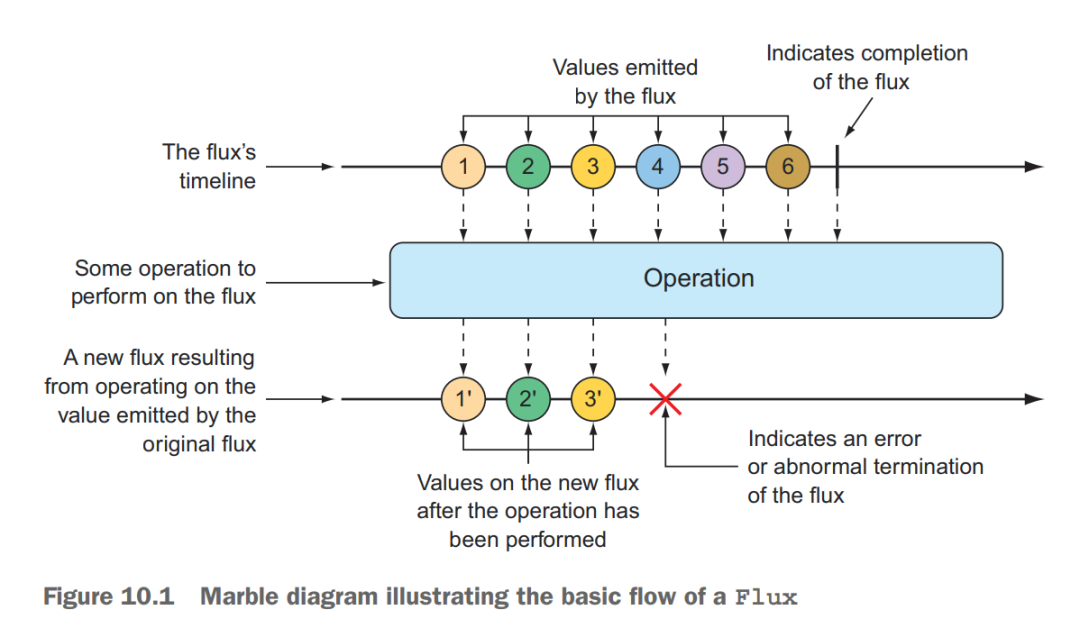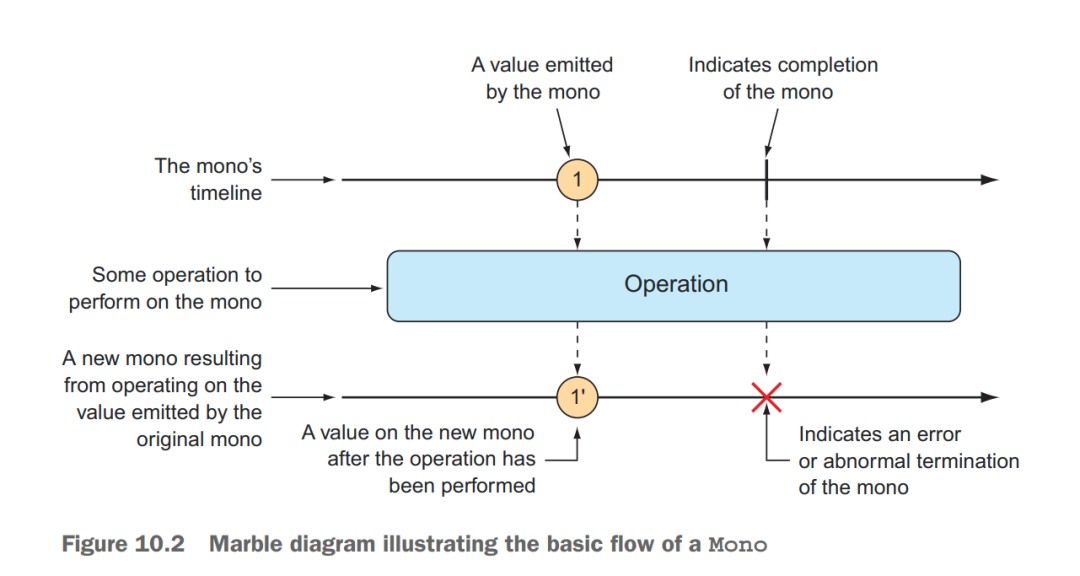Java各版本新增特性, Since Java 8
点击上方蓝色字体,选择“标星公众号”
优质文章,第一时间送达
作者 | Grey Zeng
来源 | urlify.cn/BvAR3e
Java 8
Reactor of Java 这一章来自于《Spring in Action, 5th》 的笔记,因为这本书讲Reactor of Java讲的太好了,所以作为笔记摘抄了下来。
Reactor of Java
In an imperative programming model, the code would look something like this:
String name = "Craig";
String capitalName = name.toUpperCase();
String greeting = "Hello, " + capitalName + "!";
System.out.println(greeting);
In the imperative model, each line of code performs a step, one right after the other, and definitely in the same thread. Each step blocks the executing thread from moving to the next step until complete. In contrast, functional, reactive code could achieve the same thing like this:
Mono.just("Craig")
.map(n -> n.toUpperCase())
.map(n -> "Hello, " + n + " !")
.subscribe(System.out::println);
The Mono in the example is one of Reactor’s two core types. Flux is the other. Both are implementations of Reactive Streams’ Publisher.
A Flux represents** a pipeline of zero, one, or many (potentially infinite) data items**.
A Mono is a specialized reactive type that’s optimized for when the dataset is known to have no more than one data item.


CREATING FROM OBJECTS
.just("Apple", "Orange", "Grape", "Banana", "Strawberry");
fruitFlux.subscribe(f -> System.out.println("Hello " + f));
// for test
StepVerifier.create(fruitFlux)
.expectNext("Apple")
.expectNext("Orange")
.expectNext("Grape")
.expectNext("Banana")
.expectNext("Strawberry")
.verifyComplete();
CREATING FROM COLLECTIONS
Stream fruitStream = Stream.of("Apple", "Orange", "Grape", "Banana", "Strawberry");
Flux fruitFlux2 = Flux.fromStream(fruitStream);
fruitFlux2.subscribe(s -> System.out.println(s));
List fruitList = new ArrayList<>();
fruitList.add("Apple");
fruitList.add("Orange");
fruitList.add("Grape");
fruitList.add("Banana");
fruitList.add("Strawberry");
Flux fruitFlux3 = Flux.fromIterable(fruitList);
fruitFlux3.subscribe(s -> System.out.println(s));
String[] fruits = new String[] {"Apple", "Orange", "Grape", "Banana", "Strawberry" };
Flux fruitFlux = Flux.fromArray(fruits);
fruitFlux.subscribe(s -> System.out.println(s));
StepVerifier.create(fruitFlux)
.expectNext("Apple")
.expectNext("Orange")
.expectNext("Grape")
.expectNext("Banana")
.expectNext("Strawberry")
.verifyComplete();
GENERATING FLUX DATA
Flux intervalFlux =
Flux.range(1, 5);
intervalFlux.subscribe(integer -> System.out.println(integer));
StepVerifier.create(intervalFlux)
.expectNext(1)
.expectNext(2)
.expectNext(3)
.expectNext(4)
.expectNext(5)
.verifyComplete();
Flux intervalFlux =
Flux.interval(Duration.ofSeconds(1))
.take(5);
intervalFlux.subscribe(i -> System.out.println(i));
StepVerifier.create(intervalFlux)
.expectNext(0L)
.expectNext(1L)
.expectNext(2L)
.expectNext(3L)
.expectNext(4L)
.verifyComplete();
MERGING REACTIVE TYPES
Flux characterFlux = Flux
.just("Garfield", "Kojak", "Barbossa")
.delayElements(Duration.ofMillis(500));
Flux foodFlux = Flux
.just("Lasagna", "Lollipops", "Apples")
.delaySubscription(Duration.ofMillis(250))
.delayElements(Duration.ofMillis(500));
Flux mergedFlux = characterFlux.mergeWith(foodFlux);
mergedFlux.subscribe(s -> System.out.println(s));
StepVerifier.create(mergedFlux)
.expectNext("Garfield")
.expectNext("Lasagna")
.expectNext("Kojak")
.expectNext("Lollipops")
.expectNext("Barbossa")
.expectNext("Apples")
.verifyComplete();
Flux characterFlux = Flux
.just("Garfield", "Kojak", "Barbossa");
Flux foodFlux = Flux
.just("Lasagna", "Lollipops", "Apples");
Flux> zippedFlux =
Flux.zip(characterFlux, foodFlux);
zippedFlux.subscribe(x -> System.out.println(x));
StepVerifier.create(zippedFlux)
.expectNextMatches(p ->
p.getT1().equals("Garfield") &&
p.getT2().equals("Lasagna"))
.expectNextMatches(p ->
p.getT1().equals("Kojak") &&
p.getT2().equals("Lollipops"))
.expectNextMatches(p ->
p.getT1().equals("Barbossa") &&
p.getT2().equals("Apples"))
.verifyComplete();
Flux characterFlux = Flux
.just("Garfield", "Kojak", "Barbossa");
Flux foodFlux = Flux
.just("Lasagna", "Lollipops", "Apples");
Flux zippedFlux =
Flux.zip(characterFlux, foodFlux, (c, f) -> c + " eats " + f);
zippedFlux.subscribe(x -> System.out.println(x));
StepVerifier.create(zippedFlux)
.expectNext("Garfield eats Lasagna")
.expectNext("Kojak eats Lollipops")
.expectNext("Barbossa eats Apples")
.verifyComplete();
SELECTING THE FIRST REACTIVE TYPE TO PUBLISH
Flux slowFlux = Flux.just("tortoise", "snail", "sloth")
.delaySubscription(Duration.ofMillis(100));
Flux fastFlux = Flux.just("hare", "cheetah", "squirrel");
Flux firstFlux = Flux.first(slowFlux, fastFlux);
StepVerifier.create(firstFlux)
.expectNext("hare")
.expectNext("cheetah")
.expectNext("squirrel")
.verifyComplete();
FILTERING DATA FROM REACTIVE TYPES
Flux skipFlux = Flux.just(
"one", "two", "skip a few", "ninety nine", "one hundred")
.skip(3);
StepVerifier.create(skipFlux)
.expectNext("ninety nine", "one hundred")
.verifyComplete();
Flux skipFlux = Flux.just(
"one", "two", "skip a few", "ninety nine", "one hundred")
.delayElements(Duration.ofSeconds(1))
.skip(Duration.ofSeconds(4));
StepVerifier.create(skipFlux)
.expectNext("ninety nine", "one hundred")
.verifyComplete();
Flux nationalParkFlux = Flux.just(
"Yellowstone", "Yosemite", "Grand Canyon",
"Zion", "Grand Teton")
.take(3);
StepVerifier.create(nationalParkFlux)
.expectNext("Yellowstone", "Yosemite", "Grand Canyon")
.verifyComplete();
Flux nationalParkFlux = Flux.just(
"Yellowstone", "Yosemite", "Grand Canyon",
"Zion", "Grand Teton")
.delayElements(Duration.ofSeconds(1))
.take(Duration.ofMillis(3500));
StepVerifier.create(nationalParkFlux)
.expectNext("Yellowstone", "Yosemite", "Grand Canyon")
.verifyComplete();
Flux nationalParkFlux = Flux.just(
"Yellowstone", "Yosemite", "Grand Canyon",
"Zion", "Grand Teton")
.filter(np -> !np.contains(" "));
StepVerifier.create(nationalParkFlux)
.expectNext("Yellowstone", "Yosemite", "Zion")
.verifyComplete();
Flux animalFlux = Flux.just(
"dog", "cat", "bird", "dog", "bird", "anteater")
.distinct();
StepVerifier.create(animalFlux)
.expectNext("dog", "cat", "bird", "anteater")
.verifyComplete();
MAPPING REACTIVE DATA
Flux playerFlux = Flux
.just("Michael Jordan", "Scottie Pippen", "Steve Kerr")
.map(n -> {
String[] split = n.split("\\s");
return new Player(split[0], split[1]);
});
StepVerifier.create(playerFlux)
.expectNext(new Player("Michael", "Jordan"))
.expectNext(new Player("Scottie", "Pippen"))
.expectNext(new Player("Steve", "Kerr"))
.verifyComplete();
Flux playerFlux = Flux
.just("Michael Jordan", "Scottie Pippen", "Steve Kerr")
.flatMap(n -> Mono.just(n)
.map(p -> {
String[] split = p.split("\\s");
return new Player(split[0], split[1]);
})
.subscribeOn(Schedulers.parallel())
);
List playerList = Arrays.asList(
new Player("Michael", "Jordan"),
new Player("Scottie", "Pippen"),
new Player("Steve", "Kerr"));
StepVerifier.create(playerFlux)
.expectNextMatches(p -> playerList.contains(p))
.expectNextMatches(p -> playerList.contains(p))
.expectNextMatches(p -> playerList.contains(p))
.verifyComplete();
BUFFERING DATA ON A REACTIVE STREAM
Flux fruitFlux = Flux.just(
"apple", "orange", "banana", "kiwi", "strawberry");
Flux> bufferedFlux = fruitFlux.buffer(3);
StepVerifier
.create(bufferedFlux)
.expectNext(Arrays.asList("apple", "orange", "banana"))
.expectNext(Arrays.asList("kiwi", "strawberry"))
.verifyComplete();
Buffering values from a reactive Flux into non-reactive List collections seems counterproductive. But when you combine buffer() with flatMap(), it enables each of the List collections to be processed in parallel:
Flux.just(
"apple", "orange", "banana", "kiwi", "strawberry")
.buffer(3)
.flatMap(x ->
Flux.fromIterable(x)
.map(y -> y.toUpperCase())
.subscribeOn(Schedulers.parallel())
.log()
).subscribe();
Flux fruitFlux = Flux.just(
"apple", "orange", "banana", "kiwi", "strawberry");
Mono> fruitListMono = fruitFlux.collectList();
StepVerifier
.create(fruitListMono)
.expectNext(Arrays.asList(
"apple", "orange", "banana", "kiwi", "strawberry"))
.verifyComplete();
Flux animalFlux = Flux.just(
"aardvark", "elephant", "koala", "eagle", "kangaroo");
Mono> animalMapMono =
animalFlux.collectMap(a -> a.charAt(0));
StepVerifier
.create(animalMapMono)
.expectNextMatches(map -> {
return
map.size() == 3 &&
map.get('a').equals("aardvark") &&
map.get('e').equals("eagle") &&
map.get('k').equals("kangaroo");
})
.verifyComplete();
Performing logic operations on reactive types
Flux animalFlux = Flux.just(
"aardvark", "elephant", "koala", "eagle", "kangaroo");
Mono hasAMono = animalFlux.all(a -> a.contains("a"));
StepVerifier.create(hasAMono)
.expectNext(true)
.verifyComplete();
Mono hasKMono = animalFlux.all(a -> a.contains("k"));
StepVerifier.create(hasKMono)
.expectNext(false)
.verifyComplete();
Flux animalFlux = Flux.just(
"aardvark", "elephant", "koala", "eagle", "kangaroo");
Mono hasAMono = animalFlux.any(a -> a.contains("a"));
StepVerifier.create(hasAMono)
.expectNext(true)
.verifyComplete();
Mono hasZMono = animalFlux.any(a -> a.contains("z"));
StepVerifier.create(hasZMono)
.expectNext(false)
.verifyComplete();
Spring MVC change to Spring WebFlux
@GetMapping("/recent")
public Iterable recentTacos() {
PageRequest page = PageRequest.of(
0, 12, Sort.by("createdAt").descending());
return tacoRepo.findAll(page).getContent();
}
@GetMapping("/recent")
public Flux recentTacos() {
return Flux.fromIterable(tacoRepo.findAll()).take(12);
}
@PostMapping(consumes="application/json")
@ResponseStatus(HttpStatus.CREATED)
public Taco postTaco(@RequestBody Taco taco) {
return tacoRepo.save(taco);
}
@PostMapping(consumes="application/json")
@ResponseStatus(HttpStatus.CREATED)
public Mono postTaco(@RequestBody Mono tacoMono) {
return tacoRepo.saveAll(tacoMono).next();
}
public interface TacoRepository
extends ReactiveCrudRepository {
}
@GetMapping("/{id}")
public Taco tacoById(@PathVariable("id") Long id) {
Optional optTaco = tacoRepo.findById(id);
if (optTaco.isPresent()) {
return optTaco.get();
}
return null;
}
@GetMapping("/{id}")
public Mono tacoById(@PathVariable("id") Long id) {
return tacoRepo.findById(id);
}
WORKING WITH RXJAVA TYPES
@GetMapping("/recent")
public Observable recentTacos() {
return tacoService.getRecentTacos();
}
@GetMapping("/{id}")
public Single tacoById(@PathVariable("id") Long id) {
return tacoService.lookupTaco(id);
}
Developing Reactive APIs
@Configuration
public class RouterFunctionConfig {
@Autowired
private TacoRepository tacoRepo;
@Bean
public RouterFunction routerFunction() {
return route(GET("/design/taco"), this::recents)
Testing reactive controllers 279
.andRoute(POST("/design"), this::postTaco);
}
public Mono recents(ServerRequest request) {
return ServerResponse.ok()
.body(tacoRepo.findAll().take(12), Taco.class);
}
public Mono postTaco(ServerRequest request) {
Mono taco = request.bodyToMono(Taco.class);
Mono savedTaco = tacoRepo.save(taco);
return ServerResponse
.created(URI.create(
"http://localhost:8080/design/taco/" +
savedTaco.getId()))
.body(savedTaco, Taco.class);
}
}
Test Reactive Rest APIs
// Test Get Method
Taco[] tacos = {
testTaco(1L), testTaco(2L),
testTaco(3L), testTaco(4L),
testTaco(5L), testTaco(6L),
testTaco(7L), testTaco(8L),
testTaco(9L), testTaco(10L),
testTaco(11L), testTaco(12L),
testTaco(13L), testTaco(14L),
testTaco(15L), testTaco(16L)};
Flux tacoFlux = Flux.just(tacos);
TacoRepository tacoRepo = Mockito.mock(TacoRepository.class);
when(tacoRepo.findAll()).thenReturn(tacoFlux);
WebTestClient testClient = WebTestClient.bindToController(
new DesignTacoController(tacoRepo))
.build();
testClient.get().uri("/design/recent")
.exchange()
.expectStatus().isOk()
.expectBody()
.jsonPath("$").isArray()
.jsonPath("$").isNotEmpty()
.jsonPath("$[0].id").isEqualTo(tacos[0].getId().toString())
.jsonPath("$[0].name").isEqualTo("Taco 1").jsonPath("$[1].id")
.isEqualTo(tacos[1].getId().toString()).jsonPath("$[1].name")
.isEqualTo("Taco 2").jsonPath("$[11].id")
.isEqualTo(tacos[11].getId().toString())
.jsonPath("$[11].name").isEqualTo("Taco 12").jsonPath("$[12]")
.doesNotExist().jsonPath("$[12]").doesNotExist();
// Test POST Method
TacoRepository tacoRepo = Mockito.mock(
TacoRepository.class);
Mono unsavedTacoMono = Mono.just(testTaco(null));
Taco savedTaco = testTaco(null);
savedTaco.setId(1L);
Mono savedTacoMono = Mono.just(savedTaco);
when(tacoRepo.save(any())).thenReturn(savedTacoMono);
WebTestClient testClient = WebTestClient.bindToController(
new DesignTacoController(tacoRepo)).build();
testClient.post()
.uri("/design")
.contentType(MediaType.APPLICATION_JSON)
.body(unsavedTacoMono, Taco.class)
.exchange()
.expectStatus().isCreated()
.expectBody(Taco.class)
.isEqualTo(savedTaco);
// Testing with a live server
@RunWith(SpringRunner.class)
@SpringBootTest(webEnvironment=WebEnvironment.RANDOM_PORT)
public class DesignTacoControllerWebTest {
@Autowired
private WebTestClient testClient;
@Test
public void shouldReturnRecentTacos() throws IOException {
testClient.get().uri("/design/recent")
.accept(MediaType.APPLICATION_JSON).exchange()
.expectStatus().isOk()
.expectBody()
.jsonPath("$[?(@.id == 'TACO1')].name")
.isEqualTo("Carnivore")
.jsonPath("$[?(@.id == 'TACO2')].name")
.isEqualTo("Bovine Bounty")
.jsonPath("$[?(@.id == 'TACO3')].name")
.isEqualTo("Veg-Out");
}
}
Consume Reactive APIs
Flux ingredients = WebClient.create()
.get()
.uri("http://localhost:8080/ingredients")
.retrieve()
.bodyToFlux(Ingredient.class);
ingredients.subscribe(i -> { ...})
Flux ingredients = WebClient.create()
.get()
.uri("http://localhost:8080/ingredients")
.retrieve()
.bodyToFlux(Ingredient.class);
ingredients
.timeout(Duration.ofSeconds(1))
.subscribe(
i -> { ... },
e -> {
// handle timeout error
})
//Handing errors
ingredientMono.subscribe(
ingredient -> {
// handle the ingredient data
...
},
error-> {
// deal with the error
...
});
Mono ingredientMono = webClient
.get()
.uri("http://localhost:8080/ingredients/{id}", ingredientId)
.retrieve()
.onStatus(HttpStatus::is4xxClientError,
response -> Mono.just(new UnknownIngredientException()))
.bodyToMono(Ingredient.class);
Java 9
jshell
无法用单个下划线作为变量名称
int _ = 3; // java9 or above , error
String a = Objects.requireNonNullElse(m,"Bc"); // 若m不为null,则a = m,若m为null,则a = "Bc"
-cp, -classpath, --class-path(Java9新增)
Multi-Release JAR Files
--release
--class-path instead of -classpath
--version instead of -version
--module-path option has a shortcut -p
更多,见jeps
Java8中,接口可以有静态方法的默认实现,例:
public interface Test {
public static void print() {
System.out.println("interface print");
}
default void pout() {
System.out.println();
}
}
Java9中,可以支持private的静态方法实现。
public interface Test {
private static void print() {
System.out.println("interface print");
}
static void pout() {
print();
}
}
Optional.ofNullable(date).orElseGet(() -> newDate()); // date为null,才会执行newDate()方法,否则不执行newDate()方法
Optional.ofNullable(date).orElse(newDate()); // 无论date是否为null,都会执行newDate()方法
Java7中,可以使用try-with-Resources
try(Resouce res = ...) {
work with res
}
res.close()会被自动执行
例:
try (var in = new Scanner(new FileInputStream("C:\\Users\\Young\\Desktop\\新建文件夹\\1.tx.txt"), StandardCharsets.UTF_8);
var out = new PrintWriter("C:\\Users\\Young\\Desktop\\新建文件夹\\out.txt", StandardCharsets.UTF_8)) {
while (in.hasNext()) {
out.println(in.next().toUpperCase());
}
}
in 和 out执行完毕后都会自动关闭资源
在Java9 中,你可以在try中预先声明资源
例:
public static void printAll(String[] lines, PrintWriter out) {
try (out) { // effectively final variable
for (String line : lines) {
out.println(line);
} // out.close() called here
}
}
StackWalker用法示例
public class App {
/**
* Computes the factorial of a number
*
* @param n a non-negative integer
* @return n! = 1 * 2 * . . . * n
*/
public static int factorial(int n) {
System.out.println("factorial(" + n + "):");
var walker = StackWalker.getInstance();
walker.forEach(System.out::println);
int r;
if (n <= 1) {
r = 1;
} else {
r = n * factorial(n - 1);
}
System.out.println("return " + r);
return r;
}
public static void main(String[] args) {
try (var in = new Scanner(System.in)) {
System.out.print("Enter n: ");
int n = in.nextInt();
factorial(n);
}
}
}
Java 9 expands the use of the diamond syntax to situations where it was previously not accepted. For example , you can now use diamonds with anonymous subclasses.
ArrayList list = new ArrayList<>(){
@Override
public String get(int index) {
return super.get(index).replaceAll(".","*");
}
};
Java 10
无需定义变量类型,通过var关键字+初始化的值,可以推测出变量类型
var a = 2; // a表示int
var b = "hello"; // b 表示String
var date = new java.util.Date();
var obj = new Custome(); // 自定义对象
Java 11
String repeated = "Java".repeat(3); // 三个Java字符串连接
JDK提供了jdeprscan 来检查你的代码是否使用了deprecated的方法
专题
Lambda Expression
| Method Reference | Equivalent Lambda Expression | Notes |
|---|---|---|
| separator::equals | x -> separator.equals(x) | This is a method expression with an object and an instance method. The lambda parameter is passed as the explicit parameter of the method |
| String::trim | x -> x.trim() | This is a method expression with a class and an instance method. The lambda parameter becomes the explicit parameter of the method |
| String::concat | (x, y) -> x.concat(y) | Again, we have an instance method, but this time, with an explicit parameter. As before, the first lambda parameter becomes the implicit parameter, and the remaining ones are passed to the method |
| Integer::valueOf | x -> Integer::valueOf(x) | This is a method expression with a static method. The lambda parameter is passed to the static method |
| Integer::sum | (x, y) -> Integer::sum(x, y) | This is another static method, but this time with two parameters. Both lambda parameters are passed to the static method. The Integer.sum method was specifically created to be used as a method reference. As a lmbda, you could just write (x, y)->x + y |
| Integer::new | x -> new Integer(x) | This is a constructor reference. The lambda parameters are passed to the constructor |
| Integer[]::new | n -> new Integer[n] | This is an array constructor reference. The lambda paramter is the array length |
| Functional Interface | Parameter Types | Return Types | Abstract Method Name | Description | Other Method |
|---|---|---|---|---|---|
| Runnable | none | void | run | Runs an action without arguments or return value | |
| Supplier | none | T | get | Supplies a value of type T | |
| Consumer | T | void | accept | Consumes a value of type T | andThen |
| BiConsumer | T,U | void | accept | Consumes value of types T and U | andThen |
| Function | T | R | apply | A function with argument of type T | compose, andThen, identity |
| BiFunction | T,U | R | apply | A function with arguments of types T and U | andThen |
| UnaryOperator | T | T | apply | A unary operator on the type T | compose, andThen, identity |
| BinaryOperator | T,T | T | apply | A binary operator on the type T | andThen, maxBy, minBy |
| Predicate | T | boolean | test | A boolean-valued function | and, or, negate, isEqual |
| BiPredicate | T,U | boolean | test | A boolean-valued function with two argumnets | and,or,negate |
Functional interfaces for Primitive Types
p, q is int ,long double; P, Q is Int, Long, Double
| Functional Interface | Parameter Types | Return Types | Abstract Method Name |
|---|---|---|---|
| BooleanSupplier | none | boolean | getAsBoolean |
| PSupplier | none | p | getAsP |
| PConsumer | p | void | accept |
| ObjPConsumer | T,p | void | accept |
| PFunction | p | T | apply |
| PToQFunction | p | q | applyAsQ |
| ToPFunction | T | p | applyAsP |
| ToPBiFunction | T,U | p | applyAsP |
| PUnaryOperator | p | p | applyAsP |
| PBinaryOperator | p,p | p | applyAsP |
| PPredicate | p | boolean | test |
Service Loaders
Proxies
Logging
Generic Programming
E for the element type of a collection
K and V for key and value type of a table
T(and the neighboring letters U and S, if neccessary) for "any type at all"
Pair a = new Pair<>("A", "B");
Pair b = new Pair<>(1.1, 1.11);
System.out.println(a.getClass() == b.getClass()); // TRUE
in Java8
public static Pair makePair(Supplier constr) {
return new Pair<>(constr.get(), constr.get());
}
Pair p = Pair.makePair(String:new);
In general, there is no relationship between Pair and Pair, no matter how S and T are related.
BUT
var managerBuiddies = new Pair(ceo, cfo);
Pair buddies = managerBuddies;
Collections
Concurrency
Stream
Java 8
// 流操作
List list = new ArrayList<>();
list.add(1);
list.add(2);
list.parallelStream().filter(i -> i > 1).count();
list.stream().filter(i -> i > 1).count();
Stream words = Stream.of(contents.split(","));
// 创建流
var limits = new BigInteger("1000");
Stream integerStream = Stream.iterate(BigInteger.ZERO, n -> n.compareTo(limits) < 0, n -> n.add(BigInteger.ONE));
System.out.println(integerStream.count());
如果我们持有的iterable对象不是集合,那么可以通过下面的调用将其转换成一个流
StreamSupport.stream(iterable.spliterator(),false);
如果我们持有的是Iterator对象,并且希望得到一个由它的结果构成的流,那么可以使用下面的语句
StreamSupport.stream(Spliterators.spliteratorUnknowSize(iterator, Spliterator.ORDERED),false);
至关重要的是,在执行流的操作时,我们并没有修改流背后的集合。记住,流并没有收集其数据,数据一直存储在单独的集合中
Optional
String result = optionalString.orElse(""); // The wrapped string , or "" if none
String result = optionalString.orElseGet(() -> System.getProperty("myapp.default"));
String result = optionalString.orElseThrow(IllegalStateException::new);
消费Optinal值
optionalValue.ifPresent(v -> result.add(v));
optionalValue.ifPresentOrElse(v -> System.out.println("Found" + v),
()-> logger.warning("no match"));
管道化Optional
Optional transformed = optionalString.filter(s -> s.length() >= 8).map(String::toUpperCase);
in Java9
// 如果optionalString的值存在,那么result为optionalString,如果值不存在,那么就会计算lambda表达式,并使用计算出来的结果
Optional transformed = optionalString.or(() -> alternatives.stream().findFirst());
粉丝福利:Java从入门到入土学习路线图
???

?长按上方微信二维码 2 秒
感谢点赞支持下哈 
